Are you planning to replace or upgrade your air conditioning system?
You’ll probably come across two of the business’s top brands: Carrier and Trane. Both companies provide HVAC solutions for every pocket and have quite enviable products. Can’t decide yet?
In this article, you’ll read everything you need to know before making up your mind.
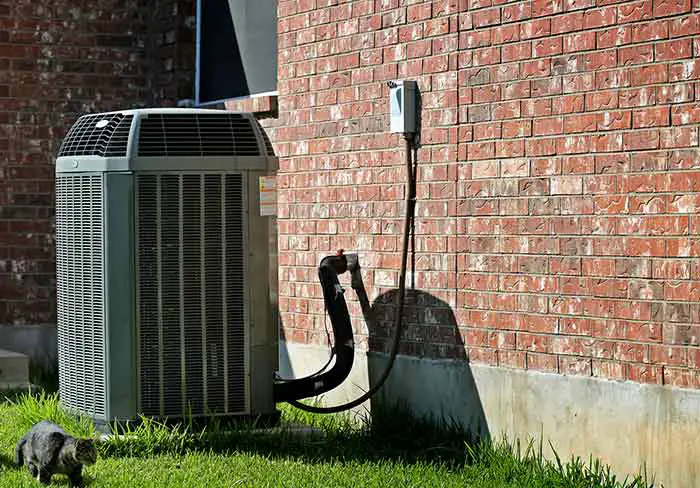
Trane vs Carrier

Trane
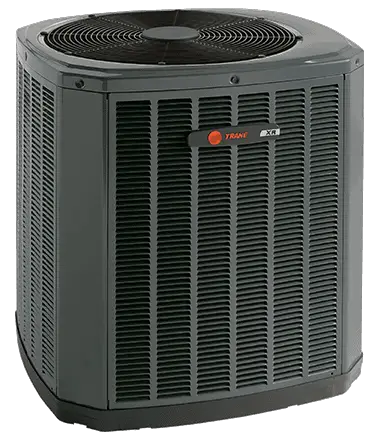
Carrier
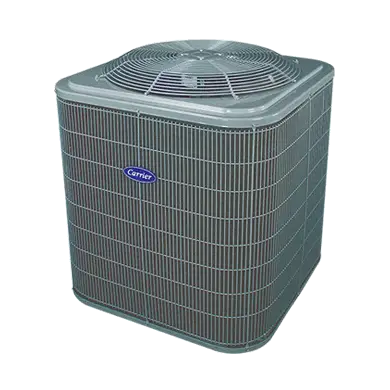
Strengths/Wins
Trane
Exclusive compressor and components
Longer warranty: at least 12 years, for top-notch ACs
Dependable and durable parts
Carrier
Hi-tech units, compatible with smart homes
Superior filtering system in higher-level ACs
Downsides/Issues
Trane
It’s more expensive than the average
Maintenance can be costly, and parts can be difficult to find
Complicated installation process
Carrier
It can be slightly less energy-efficient than Trane models
Lower models can still be expensive, despite having fewer features
Warranty is shorter than Trane’s: 10 years. But it can also be five years, depending on the model
Trane Introduction
Trane, also known as Ingersoll-Rand, is a high-quality AC manufacturer. It holds around 10% of a five million customers’ market. The company’s high-quality tradition traces back to its foundation in 1913.
They provide excellent solutions for both hot and cold temperatures. The company builds dependable appliances, which are famous for being energy efficient. Almost all Trane’s ACs bear the Energy Star® rating.
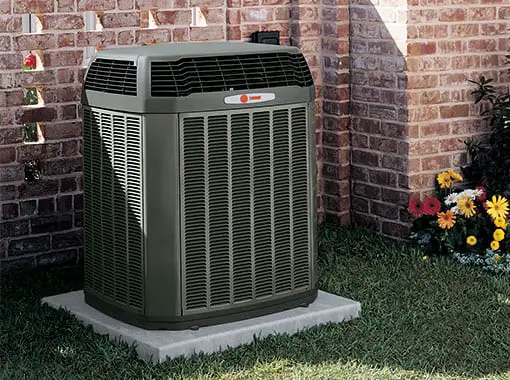
Like most AC manufacturers, Trane buys its parts from third parties. What makes this company stand out is that they always choose the best parts. It reflects on the final price of the brand’s ACs. Notice that expensive parts can lead to more expensive maintenance. They are also meticulous about installation.
Many customers prefer Trane appliances despite high prices. They slash your energy bill and have outstanding durability and dependability. Energy savings tend to make up for high prices in the long run. For those reasons, this manufacturer doesn’t provide budget options.
Carrier Introduction
Carrier is the oldest air conditioner manufacturer in the business. They have been around since 1902. This company has created what we now know as a modern air conditioning system, and it’s been leading marketing ever since.
Carrier is committed to green business practices and sustainability. Since 1994, the company has been reducing the usage of harmful gases. Appliances from this brand are also energy-efficient and have a reduced carbon footprint.
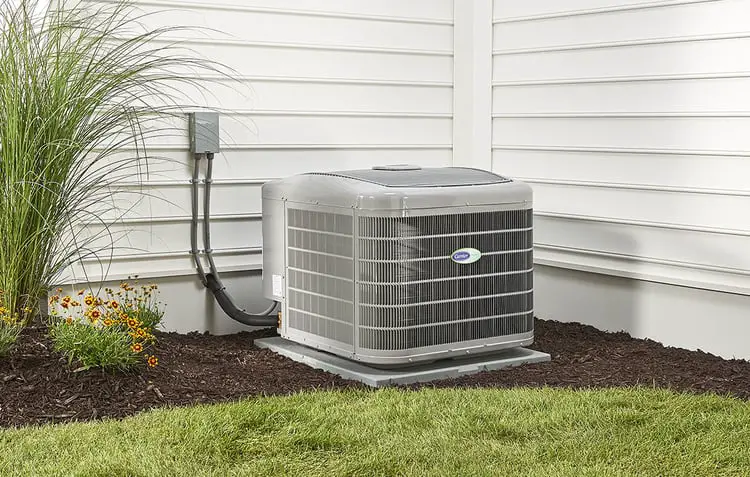
Top AC models come equipped with Greenspeed Intelligence, another Carrier’s exclusive feature. It employs adjustable speed technologies, providing greater control over temperature throughout the day.
Carrier’s air conditioners are also very quiet, especially those with two-stage compressors. Anyway, customers can also opt for sound blankets or the brand’s exclusive Silencer System II. Carrier ACs offer convenient humidity control, especially those with variable-speed compressors.
Company Comparison
The two companies are pretty similar, yet not the same. You can find some of the main differences between these brands in the table below.
|
Trane |
Carrier | |
|---|---|---|
 |  | |
|
The United States |
Where Are Their Products Made? |
Mexico |
|
Ingersoll Rand |
Who Manufactures Their Products? |
United Technologies Corporation |
|
Ingersoll Rand Inc |
Who Owns These Companies? |
United Technologies Corporation |
|
Since 1913 |
How Long Have They Been Around? |
Since 1902 |
|
12-year part warranty |
What’s Their Warranty Like? |
10-year part warranty |
What Trane Does Better Than Carrier in Air Conditioners
Trane is one of the oldest air conditioner manufacturers out there. Seconded by Carrier in age, Trane opened its doors in 1913. The company made its name by assembling the best AC parts available in the market, resulting in dependable and durable AC systems.
Like Carrier, Trane is a leading and traditional brand that provides some of the best AC units. In this section, you’ll read where it performs better than Carrier and why.
Energy Consumption
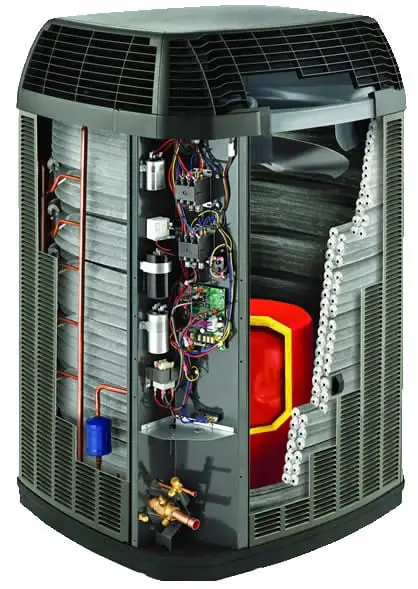
Trane’s units excel in energy efficiency and hold some of the highest SEER ratings. Trane’s top ACs can rank 22, while Carrier’s best appliances rank 21 on the SEER scale. Carrier units can provide up to 25% of energy saving. Trane’s economy falls anywhere between 30% and 40%, which is an expressive advantage.
Compressors
Assembling third-party components is a big part of an AC manufacturer’s job. Few companies manufacture their own parts nowadays. Trane is one of them and prides itself on its own compressor: the Climatuff. Climatuff has comparable performance with the best compressors available, like Copeland, for instance.
Warranty
There aren’t significant differences between both companies when it comes to warranties of budget or mid-line ACs. Yet, Trane offers better warranty conditions than Carrier for their top-tier models. They also offer a superior warranty for their compressors. Almost all Trane models offer a warranty of 10 years, at least, against the seven years offered by Carrier.
What Carrier Does Better than Trane in Air Conditioners
Both companies offer top-notch air conditioning systems, assembling parts of high-quality standards. In many aspects, Carrier and Trane are even, and there’s no incontestable winner.
Still, there are those features in which one brand holds advantages over the other. In this section, you’ll read when Carrier is the best choice.
Maintenance Costs
Carrier units have the edge over Trane ones on maintenance requirements and costs. It’s because Trane’s parts tend to be more expensive than Carrier’s. Besides, Trane’s parts can be more challenging to find if you need replacements. Many Carrier ACs come with intelligent diagnosis systems, helping technicians to fix problems.
Installation
Carrier offers better assistance when it comes to installing a new unit. Proper installation is crucial for optimal performance and more extended durability of your AC. Although truth to be told, both brands’ units need complex installation.
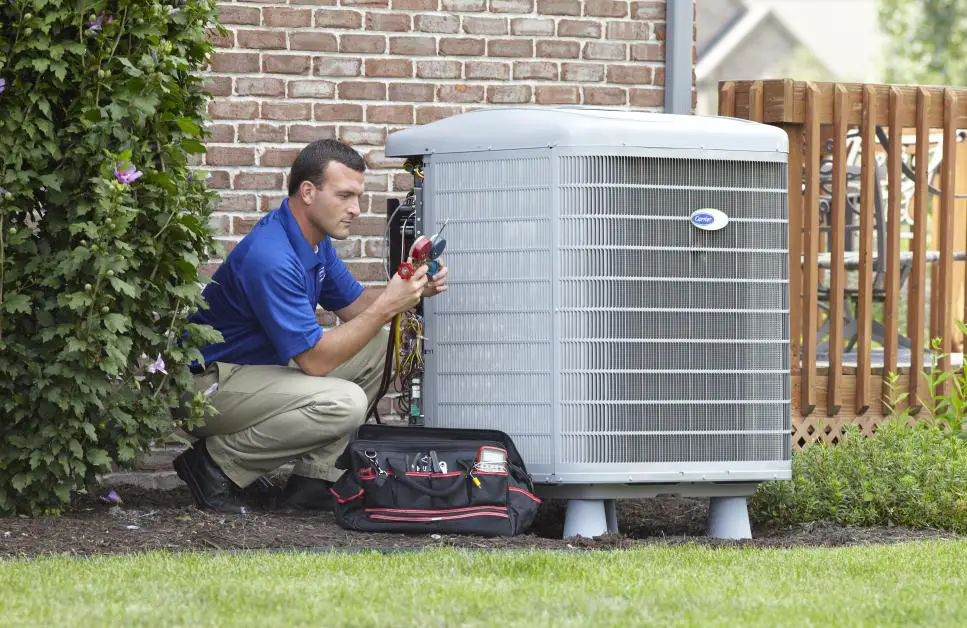
Technology
Carrier is a few steps ahead of Trane in smart home solutions. Even the most modest Carrier’s unit comes with Bluetooth and Wi-Fi functions, controlled via an app. Such an advanced communication system enables your unit to be serviced remotely by your dealer.
Carrier’s system is regularly updated, keeping your unit’s performance always at its best. It’s a great advantage if you use or plan to buy a smart thermostat for your home.
Its Greenspeed Intelligence technology allows for greater control over humidity, temperature, and airflow. Units built with this system are also 50% quieter than others.
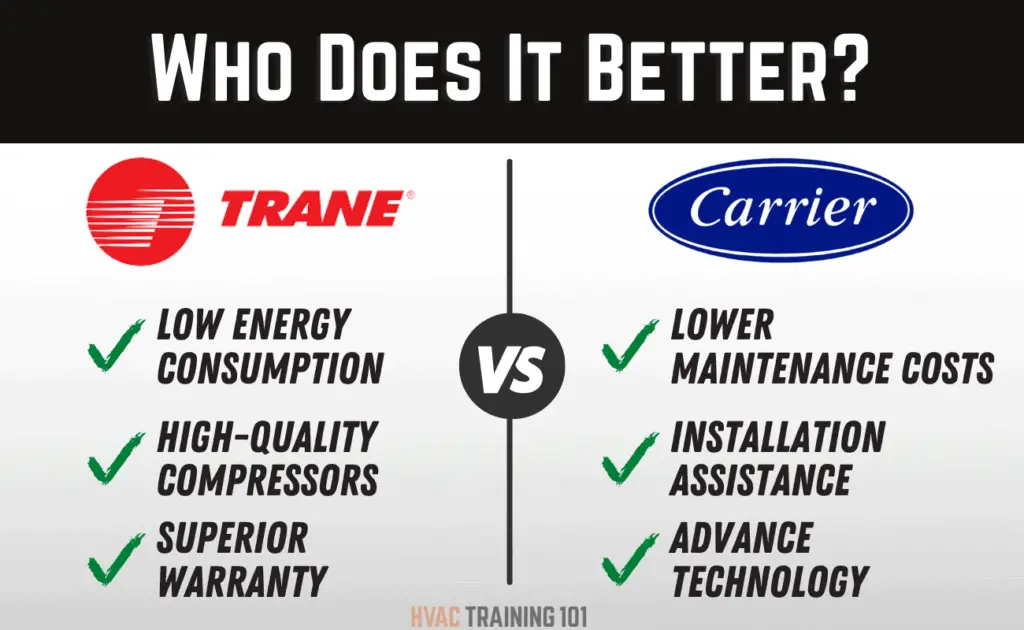
Similarities
Both manufacturers are at the top of their market, are more than a century-old, and use high-end technology and the best parts available. The same way they share the top, they also share a few features. Here are some of the main similarities between both brands.
Tiers
Despite offering some of the most advanced models available, both brands have low- and medium-budget options. It means they offer comparable units of any level. While Carrier has the Comfort Series, which is its most affordable line, Trane has XR and XL Series. Comfort Series and XLs aren’t the cheapest units out there. But they’re still much more affordable than the top ones. Both options offer an excellent cost-benefit ratio.
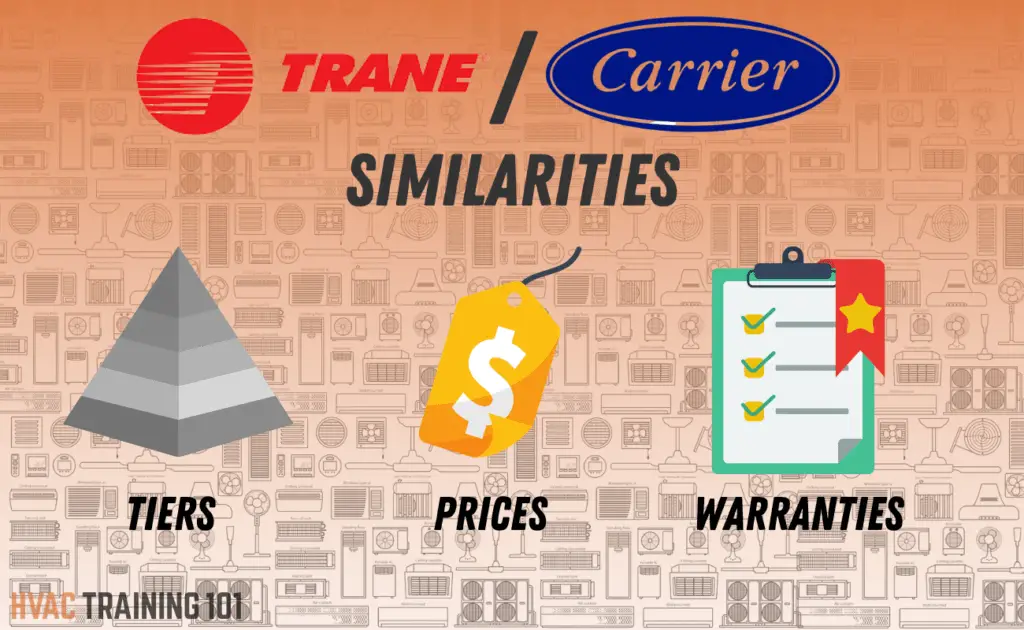
Prices
Like tiers, Carrier’s and Trane’s price range is similar. Lower lines will have competitive prices with more affordable brands while both skyrocket in the upper lines. Even for the top lines, prices tend to be the same to buy comparable facilities.
Extended warranties can also be bought at extended prices. Because there’s no clear winner here, you’ll have to base your final decision on personal tastes and tiny details.
Warranties
While Trane holds a clear advantage over Carrier’s warranties for top models, the situation is more even in the lower levels. Both companies offer similar warranties for low- and medium-budget air conditioners.
Warranty conditions and customer service also have the same standard for almost all levels. Most models have a 10-year warranty. Carrier’s Coastal Line, which offers only a five-year warranty, is an exception. This warranty protects against corrosion due to the coastal environment.
Trane vs Carrier ACs
We’ll compare Trane and Carrier systems in different models and levels. Both manufacturers have options for all climates and budgets. Below, you can find each brand’s best model, where they excel, where they are similar (or fall short) to each other, and similar models from other brands.
Flagship Model
This section discusses how and why both brands converge to the top by comparing their best units. Both have excellent qualities, and it’s up to you to decide which one will fit you best. While one has a superb air filtering system, the other has endurable parts and more extended warranties. We’ve compared them below.

Trane: XV20i
All top-quality units are expected to have exclusivities. Trane XV20i is no exception and won’t disappoint you in this sense. This model employs an all-aluminum spine fin, which improves heat transfer and airflow.
Additionally, this type of spine fin shows better resistance to leaks and corrosion. XV20i also comes with Trane’s signature compressor: the Climatuff. It has a slightly lower SEER rating than Carrier’s best option: 22.0, compared with Carrier’s 26.0.
Still, it has other exclusive parts which increase its durability, like its spine fin coils. If you don’t have a very tight budget, need an air conditioner for any weather, and want a durable appliance, this model is for you.
Carrier: Infinity 26
Infinity 26 air conditioners are the newest and best Carrier AC so far. It comes with Greenspeed Intelligence and a 26.0 SEER rating. It means it’s one of the most economical appliances you can get.
According to Carrier’s estimative, this system can save up to $129 yearly on your energy bill. Infinity 26 uses high-end technology in its communication system, with Wi-Fi and Bluetooth connections, plus Carrier’s own app. Its air purifier system, Captures & Kills, keeps the air clean, and free of excessive humidity and pathogens that regular filters usually fail to block.
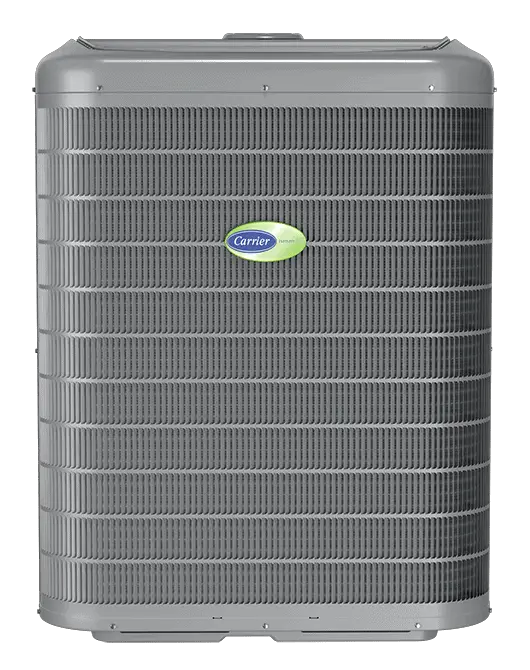
Mid-Range Model
While Trane uses its exclusive compressor and spine fin coils in its mid-priced line, Carrier uses a single-stage one, with some improvements. Both brands are a close match on SEER ratings, despite using different systems. Here, you can compare the best of the mid-range line of both brands.
Trane: XL16i
Trane’s XL Series is the brand’s mid-range models. From this line, the model XL18i excels for its energy efficiency and long durability. Its SEER rating is very high when compared with similar ACs, at 18.0. It counts on a filtering system called CleanEffects, which keeps indoor air free from pollen, dust, and other particles that may irritate.
It also uses some parts present on Trane’s flagship models, such as the spine fin coils. Additionally, it has a variable-speed fan and comes with a sound insulation system. Both features combined make up for a pretty silent unit
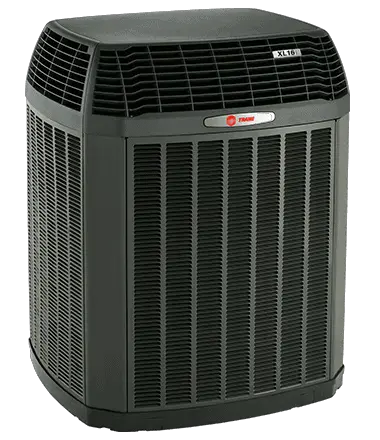
Carrier: Performance 16
Carrier’s Performance Series is the company’s mid-range line. Performance 16 stands out in this line for its energy efficiency and sound levels. It uses a single-stage compressor, which tends to be noisier and less economical. Still, Carrier makes the best of mid-priced parts to assemble a very cost-effective unit.
Talking about energy, Carrier’s Performance 16 SEER rating is up to 17.0 and holds an Energy Star certification. It also comes with a sound blanket, keeping its noise levels around 72dB in normal conditions. This model has different sizes available so that you can choose one to fit your home best.
Budget Model
Here, you can compare basic, although not wholly bare, models of Trane and Carrier. You’ll notice that most features are similar. Trane uses its traditional exclusive parts, while Carrier provides clever engineering solutions to improve otherwise ordinary components’ overall performance.
Trane: XR16
XR Series is the most affordable air conditioner manufactured by Trane. Naturally, performance won’t be the same as its top lines, especially when it comes to energy consumption. Still, this model ranks pretty well in this sense: up to 17 SEER. Its XR Series rates lower than its best models, but it’s still much higher than most ACs within the same price range.
Despite being a lower line, it still uses many of the same parts of the best units, such as the Climatuff compressor, spine fin outdoor coils, and the unique anti-corrosive base pan, the DuraTuff. All those features make this unit extremely cost-effective.

Carrier: Comfort 16 Model 24ABC6
Comfort 16 is Carrier’s basic model, designed for smaller budgets.
Still, they’re very dependable and efficient, with excellent durability, a SEER of 16.5, and an Energy Star certificate. It can slash your energy consumption by half when compared with old ACs.
It also comes with a 10-year warranty but can work efficiently for 15 years or more. It counts on a filter dryer to improve the lifespan of both compressor and refrigerant.
Additionally, the compressor is protected by pressure switches and a steel cabinet, which the company calls WeatherArmor. Its sound level is a bit higher than the average at 76dB.
Conclusion
Both companies are at the top of the AC market and at every level for consumers’ preferences. There’s no clear winner here; both have amazing and unique features and qualities that set them apart from ordinary manufacturers. So, if you want either a state-of-art home improvement appliance or a simple but efficient and durable unit, both companies can fulfill your needs.
People Also Ask
Can’t decide yet? With so many similarities and exclusive perks, it can be hard to choose. After all, buying a new air conditioner isn’t a cheap move. So, we’ve prepared this section to provide further information concisely so that you can finally make up your mind.
Carrier and Trane are two completely different companies. They’ve been competing for the top of the air conditioning market for a long time. Both offer top-quality solutions for temperature and humidity control. Yet, Carrier and Trane are not the same company, and their appliances have their exclusivities.
Trane offers several advantages on its top-tier units. One of the most remarkable being the compressor’s warranty. It has a 12-year warranty for its exclusive compressor Climatuff, against the regular 10 years most manufacturers (including Carrier) can offer. So, if you’re not on a budget, Trane is definitely worth the extra cost.
Carrier is the oldest and best air conditioner brand in the business. Technology has developed a great deal since the company first opened its doors in 1902. The company’s top units have high-end communication systems, like Wi-Fi and Bluetooth. This communication system allows for remote diagnosis, among other things.
Trane air conditioners are durable and dependable. It’s demonstrated by their parts warranty, which is at least two years more than the most durable ones at 12 years. No other brand offers such an extended warranty, especially for parts. It attests to Trane’s sturdy and resistant system.
The company estimates that a well-preserved AC unit should maintain its qualities for 10 to 15 years. Carrier offers a 10-year warranty for most of its units, except those from the Coastal line. This line is built to resist coastal corrosion. For the same reason, this line also has a shorter warranty of only five years.
